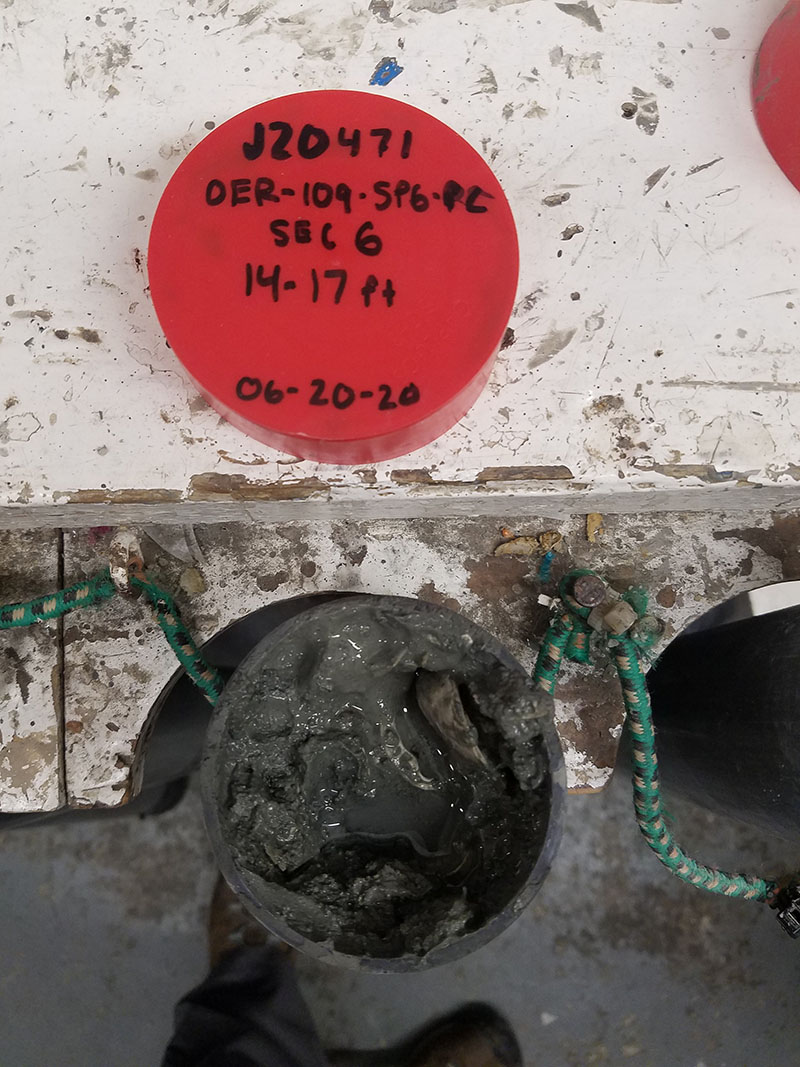
By Amanda Evans, Gray & Pape, Inc.
June 23, 2020
Our planned fieldwork consists of coring at six different locales, starting about 14.5 kilometers (9 miles) off of Port Arthur, Texas, and moving south and west towards Galveston Bay. At our farthest areas, we’re about 65 kilometers (40 miles) offshore. The continental shelf has a shallow slope, so even at this distance from shore, the water is only about 18 meters (60 feet) deep. We’re only working during daylight hours, but given the recent summer solstice, that gives us plenty of time (Figure 1).

Figure 1: With the sun rising over the horizon, the coring rig sits ready for deployment. Image courtesy of A. Herrera-Schneider, Paleolandscapes and the ca. 8,000 BP Shoreline of the Gulf of Mexico Outer Continental Shelf 2020. Download larger version (jpg, 3.3 MB).
We started our work near a rangia (clam) shell deposit reported in the 1986 Sabine River Valley study1. The original geophysical data collected in the early 1980s were printed on thermal paper, before digital data were available, and had become unusable. We selected coring locations based on our 2019 data, as well as by attempting to relocate some of the original cores. Sure enough, our cores captured rangia shell, as well as a 10-centimeter (4-inch) long piece of wood. What else did we capture? We won’t know until we open the cores.
We’re working with TDI Brooks, an established offshore company specializing in sediment coring. Their piston core is deployed from the stern of the vessel, aimed over the target, and allowed to free fall into the sediment (Figure 2).

Figure 2: The piston coring rig deployed over the stern, and just prior to sampling. Image courtesy of A. Evans, Paleolandscapes and the ca. 8,000 BP Shoreline of the Gulf of Mexico Outer Continental Shelf 2020. Download larger version (jpg, 2 MB).
Once the sample is collected, the entire rig is pulled to the surface and placed back into its cradle, which is then recovered on deck. The drill bit and core catcher are removed from the barrel and the liner removed for inventorying and sectioning. We rinse and bag anything from the core catcher and drill bit, but our only other opportunity to see what we might have comes when we section the 6-meter (20-foot) long core barrel into smaller sections for transportation and storage (Figures 3 and 4).

Figure 3: Sediment from the core catcher contained wood fragments, which were rinsed and catalogued. Image courtesy of A. Herrera-Schneider, Paleolandscapes and the ca. 8,000 BP Shoreline of the Gulf of Mexico Outer Continental Shelf 2020. Download larger version (jpg, 3.5 MB).

Figure 4: A shell deposit was observed in the core when sectioned into smaller pieces. Image courtesy of A. Evans, Paleolandscapes and the ca. 8,000 BP Shoreline of the Gulf of Mexico Outer Continental Shelf 2020. Download larger version (jpg, 5.1 MB).
We’ve completed sampling at four of our planned six locations and are now waiting on the weather to clear up so we can get back to work. After a productive first few days of coring operations, we were running ahead of schedule—then the seas picked up on us. With the back deck moving so much in the swells, it’s not safe to work. Weather is the one thing you can’t control, so now we wait.
1 Pearson, C. E., D. B. Kelley, R. A. Weinstein, and S. M. Gagliano
1986 Archaeological Investigations on the Outer Continental Shelf: A Study Within the Sabine River Valley, Offshore Louisiana and Texas. OCS Study MMS 86-0119. Coastal Environments, Inc., Baton Rouge. Submitted to Minerals Management Service, U.S. Department of the Interior, Reston, Virginia.